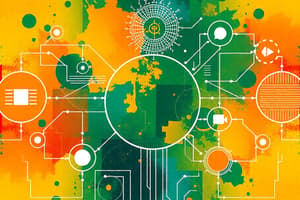Podcast
Questions and Answers
Which of the following best describes hardware in the context of an Enterprise Information System?
Which of the following best describes hardware in the context of an Enterprise Information System?
- Only the devices connected to the internet.
- All physical items including office supplies and consumables.
- Only the computer equipment used for data processing.
- The physical components that support the processing, storage, communication, and interaction of data. (correct)
Which of these components is NOT typically considered EIS hardware in the narrowest view?
Which of these components is NOT typically considered EIS hardware in the narrowest view?
- Printers
- Servers
- Routers
- Heating systems (correct)
In which scenario may an organization adopt a broader definition of EIS hardware?
In which scenario may an organization adopt a broader definition of EIS hardware?
- When focusing solely on computer networks.
- When assessing internet connectivity.
- When including all physical assets used in daily operations. (correct)
- When detailing specific software requirements.
Which of the following is an example of an analog physical asset that may be used in an organization?
Which of the following is an example of an analog physical asset that may be used in an organization?
What is a primary function of networking devices within an EIS?
What is a primary function of networking devices within an EIS?
Why might the definition of hardware vary between organizations?
Why might the definition of hardware vary between organizations?
Which of the following components is NOT considered a part of an EIS's hardware in a narrow view?
Which of the following components is NOT considered a part of an EIS's hardware in a narrow view?
What aspect of EIS hardware primarily involves physical interactions with tangible components?
What aspect of EIS hardware primarily involves physical interactions with tangible components?
Which of the following devices are considered client computers?
Which of the following devices are considered client computers?
What types of devices are included in the broader definition of IT infrastructure?
What types of devices are included in the broader definition of IT infrastructure?
Which of the following is an example of an Automated Storage and Retrieval System (AS/RS)?
Which of the following is an example of an Automated Storage and Retrieval System (AS/RS)?
What is a characteristic of Collaborative Robots (Cobots)?
What is a characteristic of Collaborative Robots (Cobots)?
Which of the following statements best describes the broadest view of EIS hardware?
Which of the following statements best describes the broadest view of EIS hardware?
What role does the Internet of Things (IoT) play in modern IT infrastructure?
What role does the Internet of Things (IoT) play in modern IT infrastructure?
Which of these devices is NOT considered a peripheral device?
Which of these devices is NOT considered a peripheral device?
When tailoring the scope of EIS hardware for a business, what should be primarily considered?
When tailoring the scope of EIS hardware for a business, what should be primarily considered?
Flashcards are hidden until you start studying
Study Notes
Introduction to EIS Hardware
- Hardware in an Enterprise Information System (EIS) encompasses all physical components that facilitate data processing, storage, communication, and interaction.
- Definitions of hardware can differ based on organizational perspective and business model.
Overview of Physical Assets
- Organizations utilize a diverse range of physical assets, from advanced robotics to standard office equipment like computers and printers.
- Analog assets like hand tools and kitchen appliances also play a role in operations.
Defining Hardware in an EIS
- Hardware is defined as the tangible components that support the functions of storing, using, changing, and sending data or software.
- Emphasis on physical items that can be physically touched.
Spectrum of Hardware Scope
- The scope of hardware in EIS varies, with definitions ranging from narrow to broad.
- Organizations can select the extent of hardware to include based on their needs, similar to the approach for People components.
Narrowest View of EIS Hardware
- Some organizations limit their EIS hardware to essential network components, which include:
- Servers: Powerful computers for centralized data management and storage.
- Networking Devices: Includes routers, switches, and firewalls for data transmission.
- Storage Devices: Hard drives, solid-state drives, and network-attached storage for data retention.
- Client Computers: Desktops, laptops, tablets, and smartphones used by employees.
- Peripheral Devices: Includes printers, scanners, keyboards, and other accessories that enhance computing.
Broader Perspective on EIS Hardware
- Many organizations adopt a wider definition, including digitalized equipment involved in manufacturing, storage, and transportation.
- Equipment categorized under the Internet of Things (IoT) is included, allowing devices to send and receive data:
- Smart Sensors: Collect real-time data on equipment performance.
- Automated Guided Vehicles (AGVs): Self-driving vehicles that assist in logistics.
- Collaborative Robots (Cobots): Operate alongside humans in production settings.
- 3D Printers: Create objects based on digital blueprints.
- Smart Conveyor Systems: Efficiently sort and transport items.
- Automated Storage and Retrieval Systems (AS/RS): Aid in warehouse management and logistics.
Broadest View of EIS Hardware
- The most comprehensive definition includes all physical equipment that contributes to data generation, even if not connected to the organizational digital network.
- Examples include standalone appliances like refrigerators, stoves, and tools involved in operational processes.
Tailoring Hardware Scope to Business Model
- Businesses should define EIS hardware according to their specific operational needs and models.
- An example includes a consulting agency that may utilize a basic kitchen stove for employee lunches.
Studying That Suits You
Use AI to generate personalized quizzes and flashcards to suit your learning preferences.



